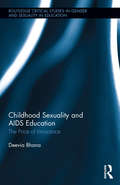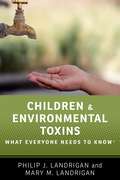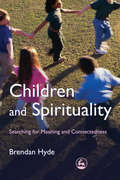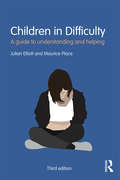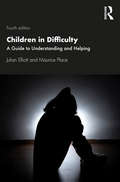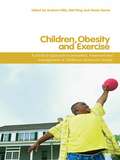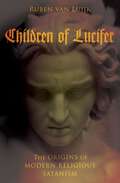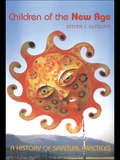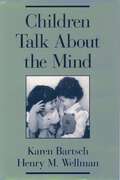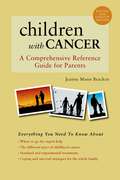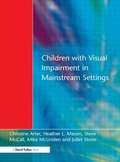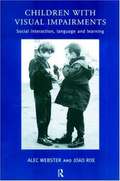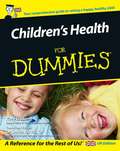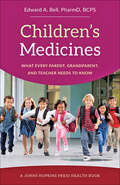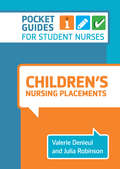- Table View
- List View
Childhood Sexuality and AIDS Education: The Price of Innocence (Routledge Critical Studies in Gender and Sexuality in Education)
by Deevia BhanaPrimary schoolchildren are frequently shielded from education on sexuality and sexually transmitted diseases in an effort to protect their innocence. In countries like South Africa, where AIDS is particularly widespread, it is especially important to address prevention with younger boys and girls as active social agents with the capacity to engage with AIDS as gendered and sexual beings. This volume addresses the question of children’s understanding of AIDS, not simply in terms of their dependence but as active participants in the interpretation of their social worlds. The volume draws on an interview and ethnographic based study of young children in two socially diverse South African primary schools, as well as interviews conducted with teachers and mothers of young children. It shows how adults sustain the production of childhood sexual innocence, and the importance of scaling up programs in AIDS intervention, gender and sexuality. It makes significant contributions to the global debate around childhood sexualities, gender and AIDS education.
Childhood Sexuality and AIDS Education: The Price of Innocence (Routledge Critical Studies in Gender and Sexuality in Education #1)
by Deevia BhanaPrimary schoolchildren are frequently shielded from education on sexuality and sexually transmitted diseases in an effort to protect their innocence. In countries like South Africa, where AIDS is particularly widespread, it is especially important to address prevention with younger boys and girls as active social agents with the capacity to engage with AIDS as gendered and sexual beings. This volume addresses the question of children’s understanding of AIDS, not simply in terms of their dependence but as active participants in the interpretation of their social worlds. The volume draws on an interview and ethnographic based study of young children in two socially diverse South African primary schools, as well as interviews conducted with teachers and mothers of young children. It shows how adults sustain the production of childhood sexual innocence, and the importance of scaling up programs in AIDS intervention, gender and sexuality. It makes significant contributions to the global debate around childhood sexualities, gender and AIDS education.
Children and Environmental Toxins: What Everyone Needs to Know® (What Everyone Needs To Know®)
by Philip J. Landrigan Mary M. LandriganMore than 80,000 new chemicals have been developed and released into the global environment during the last four decades. Today the World Health Organization attributes more than one-third of all childhood deaths to environmental causes, and as rates of childhood disease skyrocket -- autism, asthma, ADHD, obesity, diabetes, and even birth defects -- it raises serious, difficult questions around how the chemical environment is impacting children's health. Children and Environmental Toxins: What Everyone Needs to Know® offers an accessible guide to understanding and identifying the potential sources of harm in a child's environment. Written by experts in pediatrics and environmental health and formatted in an easy to follow question-and-answer format, it offers parents, care providers, and activists a reliable introduction to a hotly debated topic. As the burdens of environmental toxins and disease continue to defy borders, this book provides a new benchmark to understanding the potential threats in our environment and food. No parent or care provider should be without it.
Children and Spirituality: Searching for Meaning and Connectedness
by Brendan HydeBrendan Hyde identifies four characteristics of children's spirituality: the felt sense, integrating awareness, weaving the threads of meaning, and spiritual questing. These characteristics can be observed in children if those who work with them know what to look for and are alert to the time, place and space in which children find themselves. This book provides ways in which schoolteachers and parents can nurture and foster these particular characteristics of children's spirituality. It also considers two factors, material pursuit and trivialising, which may inhibit children's expression of their spirituality. Children and Spirituality will be of great interest to educators, policy makers, parents, and others who work with and seek to nurture the spirituality of children.
Children and Spirituality: Searching for Meaning and Connectedness (PDF)
by Brendan HydeBrendan Hyde identifies four characteristics of children's spirituality: the felt sense, integrating awareness, weaving the threads of meaning, and spiritual questing. These characteristics can be observed in children if those who work with them know what to look for and are alert to the time, place and space in which children find themselves. This book provides ways in which schoolteachers and parents can nurture and foster these particular characteristics of children's spirituality. It also considers two factors, material pursuit and trivialising, which may inhibit children's expression of their spirituality. Children and Spirituality will be of great interest to educators, policy makers, parents, and others who work with and seek to nurture the spirituality of children.
CHILDREN & ENVIRONMENTAL TOXINS WENK C: What Everyone Needs to Know® (What Everyone Needs To Know®)
by Philip J. Landrigan Mary M. LandriganMore than 80,000 new chemicals have been developed and released into the global environment during the last four decades. Today the World Health Organization attributes more than one-third of all childhood deaths to environmental causes, and as rates of childhood disease skyrocket -- autism, asthma, ADHD, obesity, diabetes, and even birth defects -- it raises serious, difficult questions around how the chemical environment is impacting children's health. Children and Environmental Toxins: What Everyone Needs to Know® offers an accessible guide to understanding and identifying the potential sources of harm in a child's environment. Written by experts in pediatrics and environmental health and formatted in an easy to follow question-and-answer format, it offers parents, care providers, and activists a reliable introduction to a hotly debated topic. As the burdens of environmental toxins and disease continue to defy borders, this book provides a new benchmark to understanding the potential threats in our environment and food. No parent or care provider should be without it.
Children in Difficulty: A guide to understanding and helping
by Julian Elliott Maurice PlaceWritten by two leading experts in the field, this welcome third edition of Children in Difficulty: A guide to understanding and helping discusses some of the most common, yet incapacitating, difficulties that are frequently encountered by young children and adolescents. This includes such topics as: ADHD disruptiveness and challenging behaviour in schools and classrooms dyslexia and reading disability eating disorders oppositional defiance, conduct and attachment disorders childhood depression school refusal developmental coordination disorder (dyspraxia) less common mental health problems, such as bipolar disorder and obsessive compulsive disorder. traumatic and stressful situations drug and solvent abuse. The third edition of this book includes brand new insights from the fields of genetics and neuroscience and ensures claims for the effectiveness of specific interventions are supported by rigorous, scientific evidence. By drawing upon high level scientific and clinical knowledge and distilling it in a way that is accessible to professionals from a range of child care disciplines, this book will be of significant value to those working in education, health or social care, and anyone who needs to be able to recognise and help children in difficulty.
Children in Difficulty: A guide to understanding and helping
by Julian Elliott Maurice PlaceWritten by two leading experts in the field, this welcome third edition of Children in Difficulty: A guide to understanding and helping discusses some of the most common, yet incapacitating, difficulties that are frequently encountered by young children and adolescents. This includes such topics as: ADHD disruptiveness and challenging behaviour in schools and classrooms dyslexia and reading disability eating disorders oppositional defiance, conduct and attachment disorders childhood depression school refusal developmental coordination disorder (dyspraxia) less common mental health problems, such as bipolar disorder and obsessive compulsive disorder. traumatic and stressful situations drug and solvent abuse. The third edition of this book includes brand new insights from the fields of genetics and neuroscience and ensures claims for the effectiveness of specific interventions are supported by rigorous, scientific evidence. By drawing upon high level scientific and clinical knowledge and distilling it in a way that is accessible to professionals from a range of child care disciplines, this book will be of significant value to those working in education, health or social care, and anyone who needs to be able to recognise and help children in difficulty.
Children in Difficulty: A Guide to Understanding and Helping
by Julian Elliott Maurice PlaceThis fully updated fourth edition of Children in Difficulty explores some of the most common, yet incapacitating, difficulties often encountered by young children and adolescents. Drawing on the latest research and with case studies throughout, chapters cover topics such as challenging behaviour and school refusal, eating disorders, anxiety and depression, substance misuse, neurodevelopmental disorders, dyslexia and dyspraxia. The book provides a deeper understanding of each difficulty, considering the complexities of each problem at depth and analysing the best forms of intervention. It includes insights from the fields of genetics and neuroscience, and ensures that claims for the effectiveness of specific interventions are supported by rigorous scientific evidence. Features of this new edition include: Up-to-date insights from the fields of psychology, genetics and neuroscience Recognition of the increasing impact of social media and the internet on children and young people. Written by experts in the field, this book distils high level scientific and clinical knowledge in a way that is accessible to professionals from a range of child-care disciplines. It will be of significant value to those working in education, health or social care, and anyone who needs to be able to recognise and help children in difficulty.
Children in Difficulty: A Guide to Understanding and Helping
by Julian Elliott Maurice PlaceThis fully updated fourth edition of Children in Difficulty explores some of the most common, yet incapacitating, difficulties often encountered by young children and adolescents. Drawing on the latest research and with case studies throughout, chapters cover topics such as challenging behaviour and school refusal, eating disorders, anxiety and depression, substance misuse, neurodevelopmental disorders, dyslexia and dyspraxia. The book provides a deeper understanding of each difficulty, considering the complexities of each problem at depth and analysing the best forms of intervention. It includes insights from the fields of genetics and neuroscience, and ensures that claims for the effectiveness of specific interventions are supported by rigorous scientific evidence. Features of this new edition include: Up-to-date insights from the fields of psychology, genetics and neuroscience Recognition of the increasing impact of social media and the internet on children and young people. Written by experts in the field, this book distils high level scientific and clinical knowledge in a way that is accessible to professionals from a range of child-care disciplines. It will be of significant value to those working in education, health or social care, and anyone who needs to be able to recognise and help children in difficulty.
Children, Obesity and Exercise: Prevention, Treatment and Management of Childhood and Adolescent Obesity (Routledge Studies in Physical Education and Youth Sport)
by Andrew P. Hills Neil A. King Nuala M. ByrneThroughout the developed world there is an increasing prevalence of childhood obesity. Because of this increase, and awareness of the risks to long term health that childhood obesity presents, the phenomena is now described by many as a global epidemic. Children, Obesity and Exercise provides sport, exercise and medicine students and professionals with an accessible and practical guide to understanding and managing childhood and adolescent obesity. It covers: overweight, obesity and body composition; physical activity, growth and development; psycho-social aspects of childhood obesity; physical activity behaviours; eating behaviours; measuring children’s behaviour; interventions for prevention and management of childhood obesity. Children, Obesity and Exercise addresses the need for authoritative advice and innovative approaches to the prevention and management of this chronic problem.
Children, Obesity and Exercise: Prevention, Treatment and Management of Childhood and Adolescent Obesity (Routledge Studies in Physical Education and Youth Sport)
by Andrew P. Hills Neil A. King Nuala M. ByrneThroughout the developed world there is an increasing prevalence of childhood obesity. Because of this increase, and awareness of the risks to long term health that childhood obesity presents, the phenomena is now described by many as a global epidemic. Children, Obesity and Exercise provides sport, exercise and medicine students and professionals with an accessible and practical guide to understanding and managing childhood and adolescent obesity. It covers: overweight, obesity and body composition; physical activity, growth and development; psycho-social aspects of childhood obesity; physical activity behaviours; eating behaviours; measuring children’s behaviour; interventions for prevention and management of childhood obesity. Children, Obesity and Exercise addresses the need for authoritative advice and innovative approaches to the prevention and management of this chronic problem.
Children of Lucifer: The Origins of Modern Religious Satanism (Oxford Studies in Western Esotericism)
by Ruben van LuijkIf we are to believe sensationalist media coverage, Satanism is, at its most benign, the purview of people who dress in black, adorn themselves with skull and pentagram paraphernalia, and listen to heavy metal. At its most sinister, its adherents are worshippers of evil incarnate and engage in violent and perverse secret rituals, the details of which mainstream society imagines with a fascination verging on the obscene. Children of Lucifer debunks these facile characterizations by exploring the historical origins of modern Satanism. Ruben van Luijk traces the movement's development from a concept invented by a Christian church eager to demonize its internal and external competitors to a positive (anti-)religious identity embraced by various groups in the modern West. Van Luijk offers a comprehensive intellectual history of this long and unpredictable trajectory. This story involves Romantic poets, radical anarchists, eccentric esotericists, Decadent writers, and schismatic exorcists, among others, and culminates in the establishment of the Church of Satan by carnival entertainer Anton Szandor LaVey. Yet it is more than a collection of colorful characters and unlikely historical episodes. The emergence of new attitudes toward Satan proves to be intimately linked to the ideological struggle for emancipation that transformed the West and is epitomized by the American and French Revolutions. It is also closely connected to secularization, that other exceptional historical process which saw Western culture spontaneously renounce its traditional gods and enter into a self-imposed state of religious indecision. Children of Lucifer makes the case that the emergence of Satanism presents a shadow history of the evolution of modern civilization as we know it. Offering the most comprehensive account of this history yet written, van Luijk proves that, in the case of Satanism, the facts are much more interesting than the fiction.
Children of Lucifer: The Origins of Modern Religious Satanism (Oxford Studies in Western Esotericism)
by Ruben van LuijkIf we are to believe sensationalist media coverage, Satanism is, at its most benign, the purview of people who dress in black, adorn themselves with skull and pentagram paraphernalia, and listen to heavy metal. At its most sinister, its adherents are worshippers of evil incarnate and engage in violent and perverse secret rituals, the details of which mainstream society imagines with a fascination verging on the obscene. Children of Lucifer debunks these facile characterizations by exploring the historical origins of modern Satanism. Ruben van Luijk traces the movement's development from a concept invented by a Christian church eager to demonize its internal and external competitors to a positive (anti-)religious identity embraced by various groups in the modern West. Van Luijk offers a comprehensive intellectual history of this long and unpredictable trajectory. This story involves Romantic poets, radical anarchists, eccentric esotericists, Decadent writers, and schismatic exorcists, among others, and culminates in the establishment of the Church of Satan by carnival entertainer Anton Szandor LaVey. Yet it is more than a collection of colorful characters and unlikely historical episodes. The emergence of new attitudes toward Satan proves to be intimately linked to the ideological struggle for emancipation that transformed the West and is epitomized by the American and French Revolutions. It is also closely connected to secularization, that other exceptional historical process which saw Western culture spontaneously renounce its traditional gods and enter into a self-imposed state of religious indecision. Children of Lucifer makes the case that the emergence of Satanism presents a shadow history of the evolution of modern civilization as we know it. Offering the most comprehensive account of this history yet written, van Luijk proves that, in the case of Satanism, the facts are much more interesting than the fiction.
Children of the New Age: A History of Spiritual Practices
by Steven SutcliffeThe first true social history of the phenomenon known as New Age culture, Children of the New Age presents an overview of the diverse varieties of New Age belief and practice from the 1930s to the present day. Drawing on original ethnographic research and rarely seen archival material, it calls into question the assumption that the New Age is a discrete and unified 'movement', and reveals the unities and fractures evident in contemporary New Age practice.
Children of the New Age: A History of Spiritual Practices
by Steven SutcliffeThe first true social history of the phenomenon known as New Age culture, Children of the New Age presents an overview of the diverse varieties of New Age belief and practice from the 1930s to the present day. Drawing on original ethnographic research and rarely seen archival material, it calls into question the assumption that the New Age is a discrete and unified 'movement', and reveals the unities and fractures evident in contemporary New Age practice.
Children Talk About the Mind
by Karen Bartsch Henry M. WellmanWhat, exactly, do children understand about the mind? And when does that understanding first emerge? In this groundbreaking book, Karen Bartsch and Henry Wellman answer these questions and much more by taking a probing look at what children themselves have to tell us about their evolving conceptions of people and their mental lives. By examining more than 200,000 everyday conversations (sampled from ten children between the ages of two and five years), the authors advance a comprehensive "naive theory of mind" that incorporates both early desire and belief-desire theories to trace childhood development through its several stages. Throughout, the book offers a splendidly written account of extensive original findings and critical new insights that will be eagerly read by students and researchers in developmental psychology, cognitive psychology, philosophy, and psycholinguistics.
Children With Cancer: A Comprehensive Reference Guide for Parents
by Jeanne Munn BrackenChildren can and do survive cancer; the last decade has seen many major advancements in treatment. Written honestly, yet in a reassuring tone, by a reference librarian whose child has survived cancer, Children with Cancer draws together a wealth of up-to-date information essential for anyone who wishes to help a child or family through this ordeal--including relatives, friends, teachers, and clergymen, as well as doctors, nurses, and other health care professionals. The information ranges from sophisticated, hard-to-find medical facts to practical tips on how to handle side effects, and much more. Describing in detail the whole range of childhood cancers, Bracken explores how they affect the child, the treatments available, how to cope with the changes this diagnosis will bring to the entire family, and where to go for both medical and emotional help. It also includes an appendix of common medical tests, a glossary of terms, and comprehensive lists of organizations, clinics, and cancer centers, complete with names and addresses. Reviews of the previous edition: "A remarkable job....The technical information is clearly stated, up to date and accurate.....But most of all, this is a human book."--Los Angeles Times "Comprehensive, well written, accurate, and compassionate.... Bracken's book can serve as a primary reference for parents and can be used as well by health care professionals and teachers." --Science Books and Films
Children With Cancer: A Comprehensive Reference Guide for Parents
by Jeanne Munn BrackenChildren can and do survive cancer; the last decade has seen many major advancements in treatment. Written honestly, yet in a reassuring tone, by a reference librarian whose child has survived cancer, Children with Cancer draws together a wealth of up-to-date information essential for anyone who wishes to help a child or family through this ordeal--including relatives, friends, teachers, and clergymen, as well as doctors, nurses, and other health care professionals. The information ranges from sophisticated, hard-to-find medical facts to practical tips on how to handle side effects, and much more. Describing in detail the whole range of childhood cancers, Bracken explores how they affect the child, the treatments available, how to cope with the changes this diagnosis will bring to the entire family, and where to go for both medical and emotional help. It also includes an appendix of common medical tests, a glossary of terms, and comprehensive lists of organizations, clinics, and cancer centers, complete with names and addresses. Reviews of the previous edition: "A remarkable job....The technical information is clearly stated, up to date and accurate.....But most of all, this is a human book."--Los Angeles Times "Comprehensive, well written, accurate, and compassionate.... Bracken's book can serve as a primary reference for parents and can be used as well by health care professionals and teachers." --Science Books and Films
Children With Visual Impairment in Mainstream Settings (PDF)
by Mike Mclinden Steve Mccall Juliet Stone Christine Arter Heather L. MasonThis text is written for teachers in mainstream settings who are about to teach pupils with a visual impairment for the first time. It describes the impact a visual impairment can have upon a pupil's access to the curriculum. The text also suggests practical ways to overcome difficulties, shares advice on assessment, differentiation and how low and high technological aids can support the pupil's work, and provides a glossary of common words and expressions used in this field and useful addresses and organisations.
Children With Visual Impairments: Social Interaction, Language and Learning (PDF)
by Alec Webster João RoeDrawing on recent research, this book presents insights into the needs of children with visual impairments. It sets out the basis for addressing the individual needs of children with such impairments, within the Code of Practice. It includes information about: opthalmics; the identification and assessment of aspects of vision; the roles of different agencies likely to be involved; and a range of practical strategies. Advice is also offered on the use of low vision aids, appropriate decor and physical layouts, lighting conditions and relevant IT.
Children's Health For Dummies
by Katy Holland Sarah JarvisYour children's good health is central to their happiness – and yours! For a parent, coping with a sick child is worrying and the amount of information you need to know can be overwhelming. But help is at hand with this practical, jargon free guide - packed full of information – providing advice on every aspect of your child’s health. Outlining all the basics from vaccinations to visiting your doctor, it also provides expert advice on keeping your child healthy and how to spot what is wrong if they do become poorly. Helpful to both first time parents and those with more than one little angel, explanations of key symptoms and typical illnesses, along with first aid advice, provide you with the ideal complete reference to your child’s health, from new-born to pre-teen.
Children's Medicines: What Every Parent, Grandparent, and Teacher Needs to Know (A Johns Hopkins Press Health Book)
by Edward A. BellMost parents have worried about the side effects and possible long-term consequences of administering a particular medication to their child. The medication may be available over-the-counter, like cough syrup, or it may be prescribed by a doctor, like an antibiotic. Parents want to know: Is the medication safe? Is it effective? Will it help my child? A pediatric pharmacist for nearly thirty years, Edward A. Bell has spent his career listening carefully to parents' concerns. In Children's Medicines, Bell draws on the latest scientific information, coupled with his experience in hospital and clinic settings, as a university professor, and as a parent, to answer questions about whether, when, and what medications to give to infants, children, and teenagers. Bell touches on practical issues of medication administration and explores areas of particular concern for parents.Inside the book, readers will find;€¢ information to help parents weigh the benefits and risks of medicines ;€¢ an explanation of why some adult medications are not safe for children ;€¢ descriptions of medicine for treating fever and common illnesses;€¢ practical tips on measuring, flavoring, and administering medicines;€¢ directions for giving medicine in the mouth, the nose, the ear, and the eye ;€¢ advice for keeping children of any age safe around medications ;€¢ facts about vaccinations: how they work, which ones are recommended, and their safety ;€¢ a guide to the FDA's approval process for use of medicines by children;€¢ information about drug pricing, expiration dates, and storing medicine at home;€¢ a chapter on ADHD and the treatment of adolescent depression that takes into account the long-term side effects of antidepressants;€¢ details about the use of herbal and complementary therapies, including probiotics and vitamins ;€¢ a discussion of over-the-counter cough/cold products;€¢ information on which websites to use for accurate medical and drug informationFull of information helpful to parents, grandparents, and others who provide care for children, Children's Medicines is a reliable and insightful guide to how drugs for children of all ages are prescribed and used.
Children's Medicines: What Every Parent, Grandparent, and Teacher Needs to Know (A Johns Hopkins Press Health Book)
by Edward A. BellMost parents have worried about the side effects and possible long-term consequences of administering a particular medication to their child. The medication may be available over-the-counter, like cough syrup, or it may be prescribed by a doctor, like an antibiotic. Parents want to know: Is the medication safe? Is it effective? Will it help my child? A pediatric pharmacist for nearly thirty years, Edward A. Bell has spent his career listening carefully to parents' concerns. In Children's Medicines, Bell draws on the latest scientific information, coupled with his experience in hospital and clinic settings, as a university professor, and as a parent, to answer questions about whether, when, and what medications to give to infants, children, and teenagers. Bell touches on practical issues of medication administration and explores areas of particular concern for parents.Inside the book, readers will find;€¢ information to help parents weigh the benefits and risks of medicines ;€¢ an explanation of why some adult medications are not safe for children ;€¢ descriptions of medicine for treating fever and common illnesses;€¢ practical tips on measuring, flavoring, and administering medicines;€¢ directions for giving medicine in the mouth, the nose, the ear, and the eye ;€¢ advice for keeping children of any age safe around medications ;€¢ facts about vaccinations: how they work, which ones are recommended, and their safety ;€¢ a guide to the FDA's approval process for use of medicines by children;€¢ information about drug pricing, expiration dates, and storing medicine at home;€¢ a chapter on ADHD and the treatment of adolescent depression that takes into account the long-term side effects of antidepressants;€¢ details about the use of herbal and complementary therapies, including probiotics and vitamins ;€¢ a discussion of over-the-counter cough/cold products;€¢ information on which websites to use for accurate medical and drug informationFull of information helpful to parents, grandparents, and others who provide care for children, Children's Medicines is a reliable and insightful guide to how drugs for children of all ages are prescribed and used.
Children's Nursing Placements: A Pocket Guide (Pocket Guides)
by Valerie Denieul and Julia RobinsonA handy, pocket-sized guide designed to make placements more enjoyable and less stressful for children's nursing students. Children’s nursing placements can be daunting – you’ll be working in a variety of settings and caring for a range of children and their families when they are at their most vulnerable. You will have new colleagues to work with, and newly learned nursing theory to put into practice. This pocket guide is designed to make your placements much more enjoyable and less stressful.
